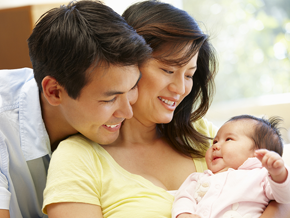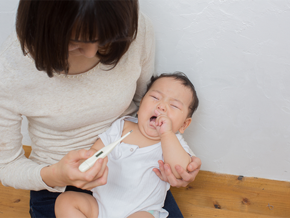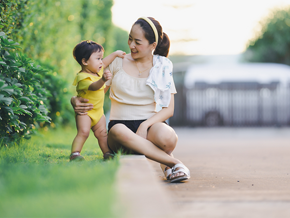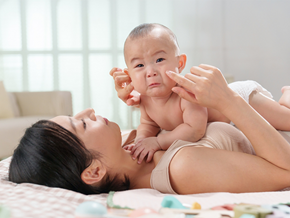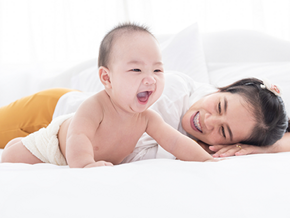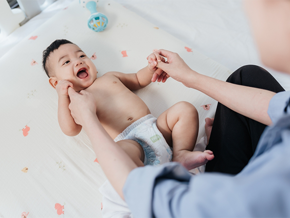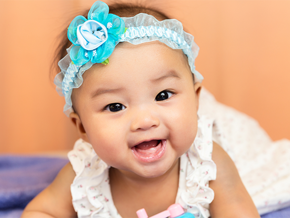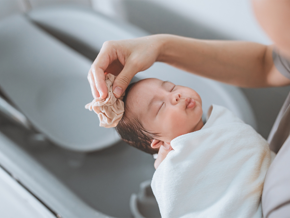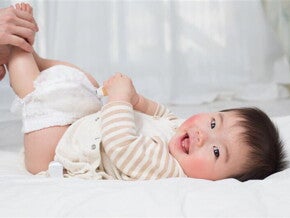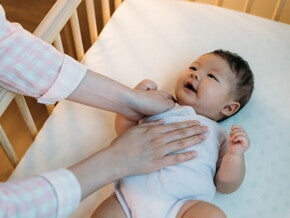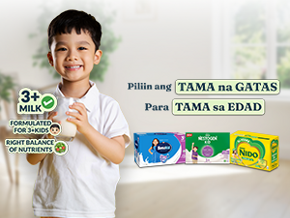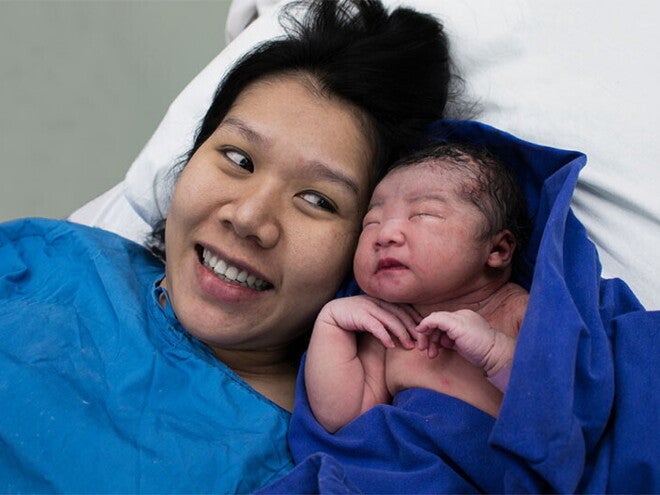
It's your first pregnancy, and you're excited to meet your baby for the first time as they lie on your chest. Capturing that moment on camera is nice, but what matters most is you and your baby experience "Unang Yakap" (first embrace). This practice carries so many science-backed emotional and health benefits that it's endorsed by global health authorities, including the World Health Organization (WHO).
To understand just how crucial that first embrace is for your baby, you have to go back to why it was established in the first place. Here's the story of Unang Yakap and its remarkable benefits.
Newborn Care Before Unang Yakap
Unang Yakap refers to the immediate skin-to-skin contact between a newborn and their mom (or dad in some cases) right after birth. It's officially known as the Essential Intrapartum and Newborn Care (EINC) protocol among health professionals.
Before EINC became a national health policy, a lot of Philippine hospitals and clinics kept moms and babies apart right after birth, delaying breastfeeding and emotional bonding. It was also common practice to immediately clamp the umbilical cord and perform routine suctioning of the baby's airways, which was often unnecessary.
Newborn care at the time also meant bathing babies right after birth. But doctors eventually learned that doing so exposed the baby to the risk of hypothermia. It also washed off the vernix caseosa, a waxy, white coating that protected babies against the risk of E. coli and Group B Strep infection.
Many healthcare providers soon realized that many newborn care procedures were not only ineffective but harmful to otherwise healthy babies. Hospitals and birthing clinics needed to unlearn these outdated practices to help lower the number of babies who don't survive after birth.
So, in December 2009, the Department of Health (DOH), with the help of WHO and the United Nations Children’s Fund (UNICEF), rolled out the EINC protocol through Administrative Order 2009-0025.
This order required all hospitals and birthing centers (public and private) to implement EINC steps to give every Filipino mom and newborn the best care possible.
How Unang Yakap Is Performed
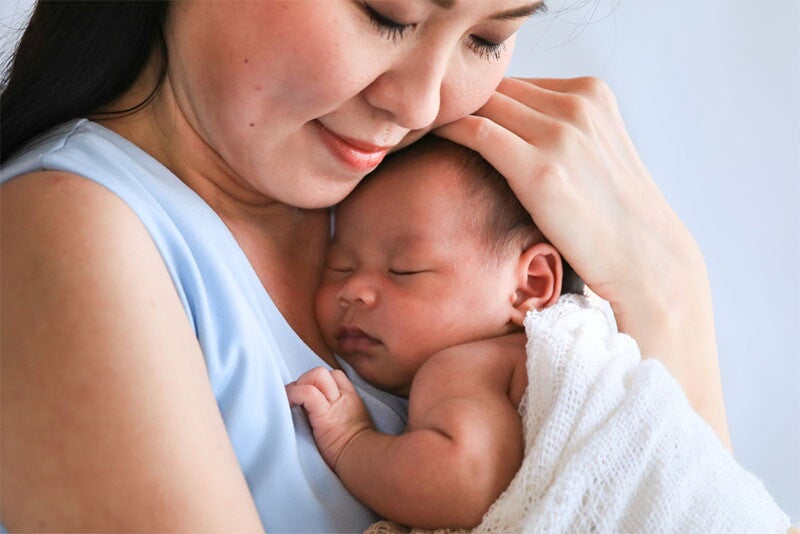
Hearing your heartbeat and feeling your warmth helps your baby feel safe.
According to the Philippine Academy of Family Physicians (PAFG), EINC involves four key steps.
Immediate and thorough drying of baby
Your medical team will thoroughly dry off your baby right after birth to keep your baby warm and check for breathing. They'll wipe your little one's face and body of any blood or meconium, a green sticky substance considered as your baby's first stool.
Skin-to-skin contact
As the medical staff dries off your baby, they've already put your newborn right on your belly, with their head near your chest. They'll position the baby to lie on their tummy with their head turned to one side to help drain fluids from their mouth or nose.
Properly timed cord clamping
Doctors or midwives now hold off on clamping the umbilical cord for about one to three minutes or until it stops pulsing. This delay helps blood flow from the placenta to the baby, giving them nutrients and oxygen.
Non-separation of the newborn from the mother
Your baby will spend an hour or two on your chest to help them start breastfeeding. Your medical team will advise you to observe for feeding cues and give you instructions on latch positions and attachment. Based on the EINC checklist, you won't be left alone during this time, with the medical staff regularly monitoring you and your baby.
After your baby has breastfed for the first time, your medical team will perform checkups at the bedside, including administering eye ointment and immunizations, as you bond with your little one.
5 Key Reasons Unang Yakap Is Essential
The implementation of Unang Yakap steps has made a huge difference in boosting in newborn survival rates, thanks to the following benefits:
Regulates baby's temperature
A mother's chest acts like a natural incubator, so your baby doesn't get too cold. Stabilizing your newborn's body temperature prevents hypothermia, which can cause serious health problems.
Reduces risk of low blood sugar
Scientists don't fully understand the mechanics, but skin-to-skin contact helps newborns maintain higher and more stable blood glucose levels than those separated from their mothers or placed under warmers.
A review of 108 studies involving nearly 85,000 newborns published in BMC Pregnancy and Childbirth shows babies who experienced skin-to-skin contact were much less likely to develop low blood sugar (hypoglycemia), a common and dangerous condition in newborns. In fact, studies showed that this simple practice cut the risk by more than half.
Shorter hospital stays
The same review in the BMC journal also reports that newborns who had skin-to-skin contact were often discharged earlier, sometimes by up to two days, compared to those who didn't.
Boosts baby's immunity
Babies pick up protective bacteria from their mother's skin, which helps build their immune systems. Meanwhile, delayed clamping of the umbilical cord allows a newborn baby to get more blood and red blood cells, which reduces the risk of anemia.
For premature babies, delayed cord clamping can lower the need for blood transfusions during their first few weeks and decrease the chances of infections and serious issues like bleeding in the brain.
Promotes breastfeeding
Babies with skin-to-skin time at birth were likelier to be exclusively breastfed before leaving the hospital. They also get colostrum, the super nutritious first milk your body produces.
Unang Yakap Benefits for Mom and Dad

Dads can perform Unang Yakap if the mom needs urgent medical attention.
Babies are born craving the warmth and security of the womb. Unang Yakap recreates that comfort, but it also helps you as a parent.
Some studies show that early skin-to-skin contact releases oxytocin (the "love" hormone) and lowers cortisol (stress hormone) not just in your system but your baby's as well. Your baby may feel calmer and relaxed while you experience less anxiety and stress.
Unang Yakap also boosts your emotional connection with your baby and makes you feel more competent and responsive to your baby's needs. And these benefits can also apply to dads!
While you typically get to hold the baby first, your partner can also perform skin-to-skin contact, especially if you need medical care or rest or the baby is born early. Holding their newborn on their bare chest helps dads bond with their baby, regulate the baby’s temperature and heart rate, and gain confidence as a caregiver.
Calming your baby’s first cries, jumpstarting their immunity, and reducing your stress when you need it the most. These are just a few of the reasons to look forward to the first embrace in your birthing experience. A core memory for sure, but Unang Yakap is also a life-saving and bond-building act of love. And it is your right to experience it, even if you give birth in a big hospital or small birthing clinic.
Talk to your healthcare provider about including it in your birth plan to give your baby a happy and healthy start!
Do you remember your Unang Yakap experience? Let's talk about it on ParentTeam's Facebook group. Here's to a more empowered journey into motherhood!
References
Pilar V. Domagsang et al., “Implementation of Essential Intrapartum and Newborn Care Among Health Care Providers,” Proceedings of 138th the IRES International Conference, (August 30, 2018), accessed June 1, 2025, https://worldresearchlibrary.org/up_proc/pdf/1876-153925694726-32.pdf.
Gary Humphreys, “Maria Asuncion Silvestre: Improving Neonatal Care,” Bulletin of the World Health Organization 101, no. 08 (August 1, 2023): 499–500, https://doi.org/10.2471/blt.23.030823.
Ann E. Bigelow and Michelle Power, “Mother–Infant Skin-to-Skin Contact: Short‐ and Long-Term Effects for Mothers and Their Children Born Full-Term,” Frontiers in Psychology 11 (August 28, 2020), https://doi.org/10.3389/fpsyg.2020.01921.
Chiara Ionio, Giulia Ciuffo, and Marta Landoni, “Parent–Infant Skin-to-Skin Contact and Stress Regulation: A Systematic Review of the Literature,” International Journal of Environmental Research and Public Health 18, no. 9 (April 28, 2021): 4695, https://doi.org/10.3390/ijerph18094695.












